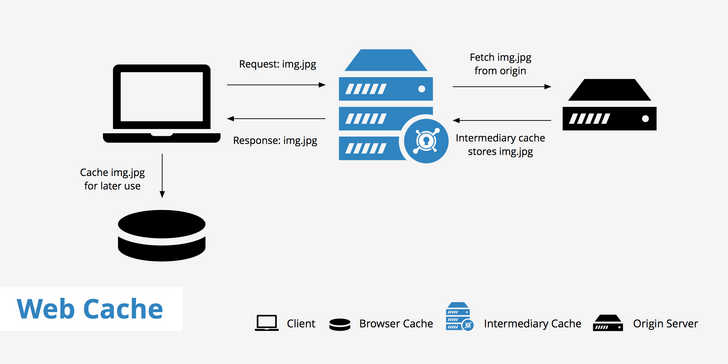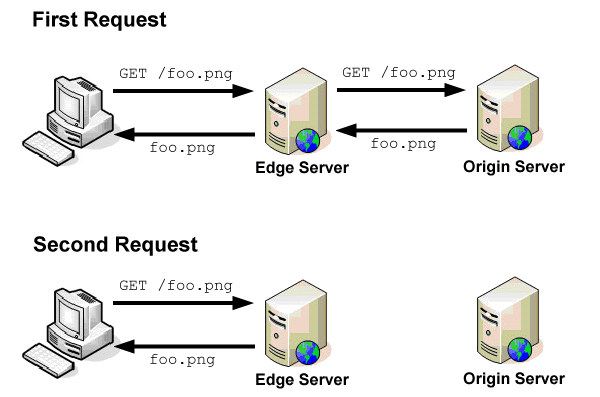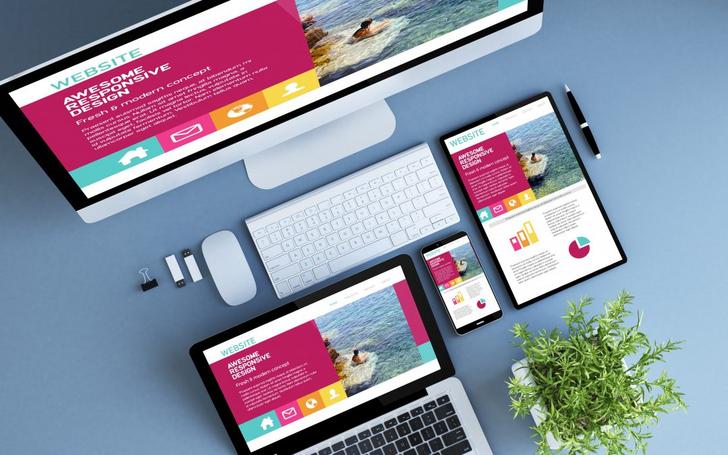Web design is a wide, varied, and rapidly-evolving line of work. The market for web design is incredibly competitive – this means that if you want to stay on the cutting edge, you’re going to have to acquire a wide knowledge base.
Combining the skills of a web designer and a web developer opens a path for a lucrative endgame, career-wise. But even if that isn’t your goal, a more well-rounded understanding of the bigger picture will allow you to stand out and provide your clients with a much better end-product.
No matter what niche of web design you currently occupy, knowing at least the basics of caching is quickly becoming a necessity
Caching is an incredibly useful feature that works by temporarily storing data closer to the user. By distributing shared page elements such as Javascript, CSS, and images this way, a website can attain a host of benefits – all of which positively impact the underlying business.
Whereas caching was once a novel approach, in today’s world it has become almost an absolute requirement for any website that wants to attain top of the line performance and offer a high level of service.
We won’t delve too deeply into the nitty-gritty technical side of things today – but you’ll be much better off knowing the basics of caching, the potential benefits that it can bring, how it relates to web design, and the possible pitfalls and disadvantages that you should look out for.
How Internet Caching Affects Web Design
What is Caching?
Put in the simplest of terms, caching is a method of storing data closer to the user. This means that the data isn’t retrieved the usual way, through your servers – and this can provide you with a host of benefits.

What Information can be Cached?
Cache settings can be adjusted to apply to a wide variety of content. But it isn’t that simple – you shouldn’t be thinking of it in terms of what can be cached – but in terms of what should be cached.
As a general rule of thumb, the less frequent content changes, the more cache-friendly it is. Dynamic content isn’t harder to cache than static content – but caching it can lead to a few issues – we’ll go into greater detail later.
Media files, logos, images, downloadable content, javascript files, stylesheets, CSS and fonts are generally the prime candidates for caching.
HTML files, Javascript and CSS that are often modified, user-specific pages, and assets that deal with sensitive data are problematic. The last two items on this list should never be cached – when it comes to the others, you should approach them on a case-by-case basis. The expiration time for content can be adjusted – allowing you to cache even those problematic items – provided you do the work and find an approach that works for you.
Types of Caching
Broadly speaking, there are three types of web caching – local browser caching, ISP or proxy caching, and CDN or content delivery network caching.
Browser caching stores data in the user’s own browser. After they visit the site for the first time, flagged assets will be downloaded – and on each subsequent visit, the browser will first check to see what assets it already has available.
Browser caching is very common, and, provided you set an appropriate expiration date using cache-control headers, it’s a very effective tool.
ISP caching uses the servers of your internet provider to achieve the same goals. However, you have significantly less control over how long the cached files will be stored – which makes choosing an appropriate ISP a high priority. We’ll delve deeper into the possible issues with ISP caching later.
CDN or content delivery network caching uses a distributed network of servers to provide users with content. Seeing as how the servers are spread out, they’re much more likely to be geographically closer to your users.
Dedicated proxy caching involves using specialized proxy servers solely for caching purposes. When users request content from the internet, these dedicated proxy servers intercept the requests and serve cached content directly if available, reducing bandwidth usage and improving network performance. This method is commonly utilized in enterprise environments and ISPs to optimize internet access for users by caching frequently accessed content.

The Benefits of Caching and How It Relates to Web Design
Now that we’ve covered the basics, let’s take a look at some concrete examples of how caching can benefit a website.
Responsiveness and Performance
Obviously, storing files closer to the user results in much faster loading times. In the case of browser caching, large parts of the website can be loaded almost instantaneously – but even ISP and CDN caching provide much faster load times.
The responsiveness of a website is always a priority. Not only is it a huge part of the overall user experience, but it also goes a long way in reducing bounce rates – and these two points go a long way in ensuring a successful business. Having websites built to be browser and device-specific also greatly improve loading time and overall functionality. Sites built to serve readers a specific variation of their theme or build based on their settings can have massive reductions in load time yet only 11% of WordPress websites utilize this function.
Availability
Caching can be set up in a way that allows users to access content even when it may be temporarily unavailable. This is particularly where content delivery networks, such as Cloudflare, particularly shine.
Although in ideal conditions, content availability shouldn’t be an issue, real-life conditions are hard to predict. Caching provides a simple, straightforward solution to a problem that can’t otherwise be planned for.
Reduced Congestion, Network Traffic, Bandwidth Consumption, and Costs
Network congestion is also hard to predict, but a good caching policy goes a long way in alleviating that problem. Distributing assets to be closer to the users also requires less network traffic that is directed to the origin server – this reduces bandwidth consumption.
In turn, this also allows non-cached content to be retrieved faster as well. Spreading the workload in this way also reduces the risk of the server crashing, and allows you to achieve greater, and more reliable results than you normally would, without requiring a hardware upgrade.
Overall, the reduced network activity and bandwidth consumption will also reflect on the expenses of your website – significantly reducing them, while providing greater performance.
Improved SEO Performance
Caching positively impacts SEO efforts by improving loading times and website responsiveness, key factors in search engine rankings. It aids in reducing page load times and server response times, factors Google considers when ranking websites. Effective caching strategies indirectly boost SEO performance, increasing visibility and traffic from search engines.
Enhanced Scalability and Flexibility
Caching enhances the scalability and flexibility of a website by efficiently distributing workload as traffic increases, reducing strain on the server. This ensures the website can handle traffic spikes without performance issues or downtime.
Additionally, caching reduces dependency on server resources, enabling easier scalability. Websites with effective caching mechanisms handle traffic fluctuations without compromising performance or user experience. Caching also facilitates seamless implementation of changes or updates by minimizing the impact on server resources and ensuring consistent content delivery to users.
Enhanced User Experience
Caching significantly improves user experience by ensuring faster and more responsive website performance. With cached content stored closer to the user, pages load more quickly, reducing waiting times and providing a smoother browsing experience. Fast-loading pages contribute to higher user satisfaction and engagement, as visitors are more likely to stay on a website that delivers content promptly. Additionally, cached content remains accessible even when the network connection is slow or temporarily unavailable, allowing users to access essential information without interruption.
How Caching Relates to Web Design
The benefits of caching are enormous – with regard to web design, the increased responsiveness and faster load times are the most important. They may allow you to utilize more resource-intensive elements in your site’s design – but this is a matter of degree, as you shouldn’t squander the newfound responsiveness and load times of your site without a good reason.

Caching policy is also immensely important in the eyes of web design. Your caching policies shouldn’t be set in stone – rather, they should be regularly audited and adjusted to ensure maximum performance.
Whether you handle this by yourself, or in conjunction with another member of your team, the size of the cache, the expiration date of files, the system of invalidating a cache or cache-busting as it’s often called, dealing with stale content, and setting up a well-oiled system of proxy servers via a CDN are all important issues – and all of them have an effect on site performance and content availability – two of the most important goals of web design.
Potential Problems to Look Out For
When it inevitably becomes necessary to clear a cache, you’re opening yourself up to a huge traffic spike. Cache clearing should be planned in advance, and if possible, segmented and done step by step.
Whenever you make use of third-party services to enjoy the benefits of caching, you become dependent on them, security-wise. If they are compromised by a malicious attack, your website and/or its users might also be in danger. This is a given, and shouldn’t discourage you from using a CDN – but it does highlight the importance of choosing a reputable, secure network.
Maintaining a high level of customer service is the best way to quickly deal with possible caching issues. You should keep in mind that using a single proxy cache will always lead to bottlenecks, as well as disruptions should the proxy run into issues.

